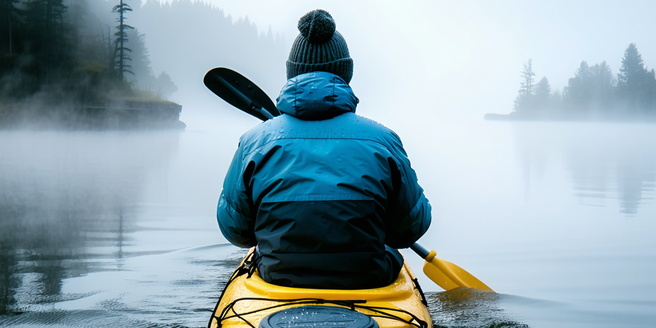
Understanding Humidity and Its Role in Kayaking
Humidity is a crucial yet often overlooked factor in kayaking. It plays a significant role in determining both comfort and safety on the water. High humidity levels can result in fatigue, as the body works harder to cool itself when moisture is present in the air. Meanwhile, low humidity might cause dehydration more quickly. Understanding these impacts helps kayakers prepare adequately for their adventures. Moisture in the air can also affect how equipment, such as paddles and kayaks themselves, respond and handle. Gear that suffers from condensation or feels damp will require additional maintenance. To embark on a safe and comfortable expedition, knowledge of the day’s humidity levels is as essential as knowing the tides or wind speed. Hence, paddlers need to consistently monitor these conditions to minimize risk.
How High Humidity Affects Your Kayaking Experience
Kayaking in conditions of high humidity can influence both the experience and the performance of the paddler. When the air is saturated with moisture, it can become challenging to maintain energy levels. The high moisture content can make breathing feel labored and might increase perceived exertion, leading to quicker fatigue. It’s also important to recognize that sweat doesn’t evaporate as efficiently, making it harder for the body to cool itself. This physiological response may lead to an increased risk of overheating or heat-related illnesses. Additionally, high humidity can affect the stability of the kayaking vessel as equipment becomes slippery. It necessitates careful planning, including hydration strategies and breaks, to ensure that the paddling journey remains enjoyable and safe. Awareness and preparation are key elements in successfully navigating humid conditions.
The Impact of Low Humidity on Kayak Performance
Low humidity introduces a slew of considerations for kayakers that are fundamentally different from those in high humidity scenarios. One primary concern is dehydration, as reduced water vapor in the air can increase perspiration rates, leading to fluid loss. As kayakers engage in these physically demanding activities, staying hydrated is crucial to maintain energy levels. Additionally, low humidity can also affect the structural integrity of kayaks, particularly those made from materials prone to shrinkage or increased brittleness in drier conditions. This might impact handling and maneuverability. Such environments can create a false sense of dryness, potentially leading to neglect in applying sunscreen and other skin protection against UV exposure. Anticipating these elements allows kayakers to adapt their strategies, ensuring equipment performance doesn’t suffer while maintaining personal safety.
Safety Tips for Kayaking in Different Humidity Levels
Adapting to various humidity levels is essential for safety and comfort while kayaking. In high humidity, it’s crucial to prioritize hydration and take frequent breaks to allow the body to cool down. Lightweight, moisture-wicking clothing can help manage comfort. Conversely, in low humidity conditions, the temptation to underestimate sun exposure is significant, so wearing sunscreen and protective clothing is advisable. Both extremes demand vigilance in monitoring personal condition and regular fluid intake. Equally important is the upkeep of equipment; high humidity necessitates drying gear thoroughly post-trip to prevent mold, whereas low humidity requires checking for material degradation. Ultimately, flexibility and a proactive approach to preparation are pivotal in managing the impacts of humidity. Educating oneself about expected conditions and having contingency plans can mitigate risks.
Choosing the Right Gear for Humid Kayaking Conditions
Selecting appropriate gear tailored for the humidity level encountered is fundamental for a safe and enjoyable kayaking expedition. In humid environments, clothing made from quick-drying, breathable materials enhances comfort and temperature regulation. Footwear needs to provide good grip on damp surfaces to prevent slipping, while waterproof bags or containers are crucial for protecting sensitive gear. Conversely, for low humidity, attention shifts to clothing that offers sun protection and moisture retention to combat dryness. Sun hats and polarized sunglasses become essential accessories, limiting glare and exposure. It’s also wise to incorporate materials that can withstand the drying effects of low humidity to ensure prolonged durability. Thus, conscientious gear selection tailored to specific humidity nuances can significantly enhance kayakers’ comfort, safety, and overall enjoyment of their journey, ensuring preparedness in any circumstance.
Humidity’s Influence on Water Conditions and Wildlife
Humidity levels play a pivotal role not just in shaping the atmospheric environment but also in altering water conditions and affecting wildlife during kayaking expeditions. High humidity often coincides with warmer water temperatures, potentially leading to increased growth of algae and affecting aquatic ecosystems. Kayakers may notice changes in water clarity or encounter more vegetation, impacting navigation. Conversely, low humidity can lead to cooler, crisper paddling conditions but may also reduce the abundance of certain wildlife in visible areas. These shifts could influence the type of wildlife sightings kayakers experience, with some species becoming more elusive. Understanding these ecological dynamics allows paddlers to better appreciate the environment and exercise greater caution, ensuring that their interactions with nature remain respectful and minimally intrusive. Awareness fosters environmental stewardship and enhances the richness of the kayaking experience.
